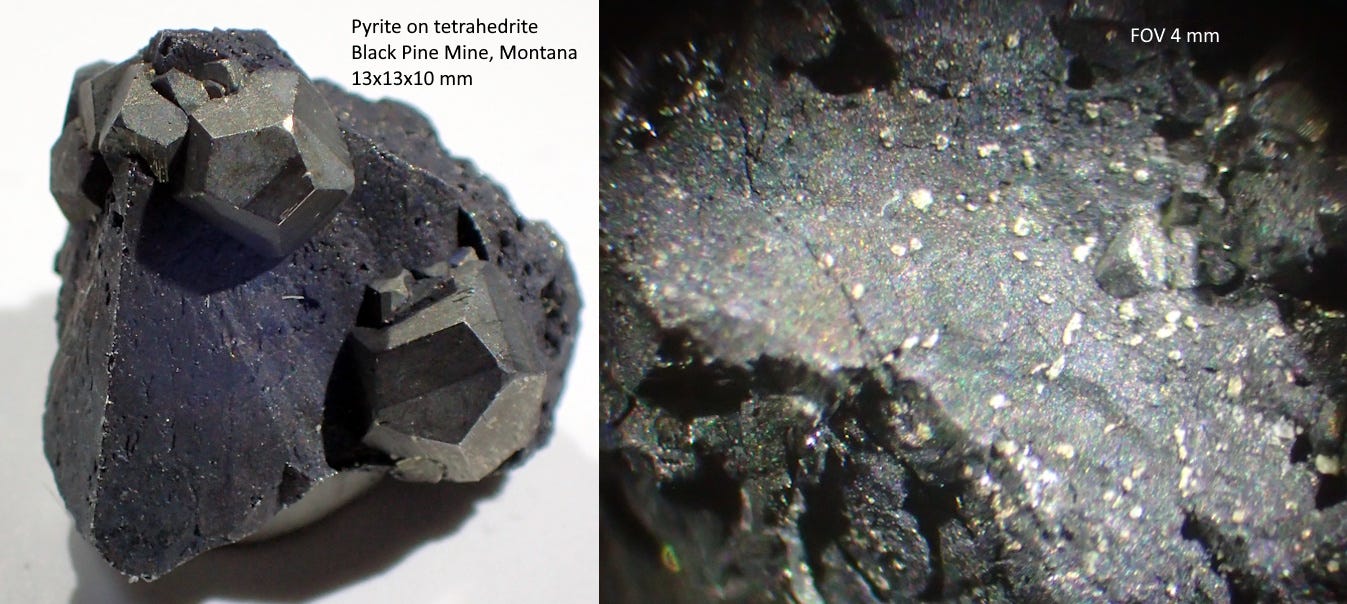Life in the USA is not normal. It feels pointless and trivial to be talking about small looks at the fascinating natural world when the country is being dismantled. But these posts will continue, as a statement of resistance. I hope you continue to enjoy and learn from them. Stand Up For Science!
Tetrahedrite is one of the most straightforwardly named minerals: it typically forms tetrahedrons, from Greek for “four faces.” The four faces are ideally identical equilateral triangles that come together to make a closed form, but as with most minerals, faces and edges may develop unequally and in intergrown fashions resulting in skewed crystals that may not show the full symmetry.
Tetrahedrite, the antimony (Sb) end member Cu12Sb4S13, extends in a series to tennantite, the arsenic (As) end member Cu12As4S13. Additionally many other metals can substitute for copper, making for a whole plethora of series, with formulas like Cu6(Cu4Fe2+2)As4S12S, tennantite-(Fe); Cu6(Cu4Zn2)Sb4S12S, tetrahedrite-(Zn); and others toward each end with dominant copper, silver, cadmium, mercury, indium, manganese, and nickel, each a defined species. To complicate it further, arsenic or antimony can be replaced by bismuth or tellurium, and selenium can also replace sulfur there at the end of the formula.
Tennantite honors English chemist Smithson Tennant (1761-1815) who discovered the elements iridium and osmium in 1803. I would have provided an image of Tennant, but I think virtually all the images on the internet labeled “Smithson Tennant” are actually James Smithson, namesake of the Smithsonian Institution.
Like many minerals nowadays, “tetrahedrite” has been redefined as the tetrahedrite group, which contains eleven subgroups. The tetrahedrite subgroup itself holds seven defined minerals; the nomenclature and relationships among all these entities are extremely complex. If you seek a deep dive into the details, start with this paper from American Mineralogist (Biagioni and others, 2020, The tetrahedrite group: Nomenclature and classification: Am. Mineral. 105:109-122).
Historically the mineral freibergite was the silver-dominant version of tetrahedrite, but now it’s a subgroup with 6 members, such as argentotetrahedrite-(Zn), Ag6(Cu4Zn2)Sb4S12S. It’s all enough to make a field mineralogist weep. I actually love that kind of thing (up to a point) but sometimes it’s just way too much!
Without analysis, or at a minimum, deep expertise in a given mineral deposit, I think it would be irrational to say a particular specimen is any of the many varieties within the group or subgroup, so I’m just saying “tetrahedrite” here. Just recognize that I don’t know the detailed chemistry.
For my purposes, I’m focusing mostly on the silver contained in tetrahedrite. According to Le Comptoir Géologique, “The tetrahedrite-freibergite association is the main silver reservoir on the planet, far ahead of silver sulphides, which are richer in silver but less abundant.” At the Black Pine Mine, near Philipsburg, Montana, “tetrahedrite” was the primary ore of silver (Waisman, 1992, Minerals of the Black Pine Mine, Granite County, Montana: Mineralogical Record 23:477), and most of the specimens I’m showing here are from there.
Some, perhaps much, silver is bound crystallographically into the tetrahedrite structure, making things like the argentotetrahedrite-(Zn) mentioned above. But at Black Pine (and elsewhere), there’s a lot of silver in tetrahedrite that’s native silver physically incorporated into the tetrahedrite but crystallographically distinct from it. One way that can happen is through exsolution.

Exsolution is the process in which a chemically mixed solution or melt cools, but the silver content cannot be accommodated in the crystallizing structure of tetrahedrite. It exsolves, comes out of solution, as pure blobs of silver scattered through tetrahedrite which may or may not otherwise be silver-bearing. Temperature changes affect the tetrahedrite’s ability to hold silver ions in its structure, so the silver comes out separately but physically within the same crystal.
What that means in practice is tiny blebs and stringers of native silver, sharply contrasted against the dark tetrahedrite that includes them. Those in my specimens are readily evident microscopically.
In addition, silver occurs at Black Pine as a patina on the surface of tetrahedrite crystals. The late Chris van Laer described one as “A single tetrahedrite crystal, partly coated with a patina of native silver. The silver has been electrolytically deposited on the surface of the tetrahedrite crystal.” I’m not sure I’d go so far as to call it “electrolytically deposited.” I’d probably go for some kind of electrochemical process related to the extent of metal ions in the solutions, but I’m by no means any kind of expert on that.
On some of my specimens the patina seems to be exactly that, a thin surface layer. But for some others that have broken edges, it looks like the silver extends to the interior of the tetrahedrite body as well, so perhaps some of the “patinas” are some kind of alteration phenomenon affecting silver-rich tetrahedrite. I definitely don’t know.
Tetrahedrite at Black Pine seems to alter readily to a yellow antimony oxide, bindheimite.
For what it’s worth, on MinDat this material at Black Pine is usually given as tetrahedrite subgroup, while Butte has far more tennantite subgroup than tetrahedrite, and Lester Zeihen, prominent Butte mineralogist, suggested that most of the material at Butte is tennantite (Jenkins and Lorengo, 2002, Butte, Montana: Minerals, mines, and history: Mineralogical Record 33). Tetrahedrite definitely does occur at Butte, however (Evanich, 2025, Minerals from the historic mines of Butte, Montana: Rocks & Minerals, 100:4, p. 326).
When it’s all said and done, I guess this post was mostly to share the kind of curiosity (and ensuing rabbit holes) I derive from recognizing tiny native silver blebs inside a tetrahedrite crystal.
All of the Black Pine specimens here are ex-Bill Stanford via dealer Paul Senn. The Butte tennantites are ex-Guy Palmer.









Have found this name format helps to focus a search. Tennant, Smithson.